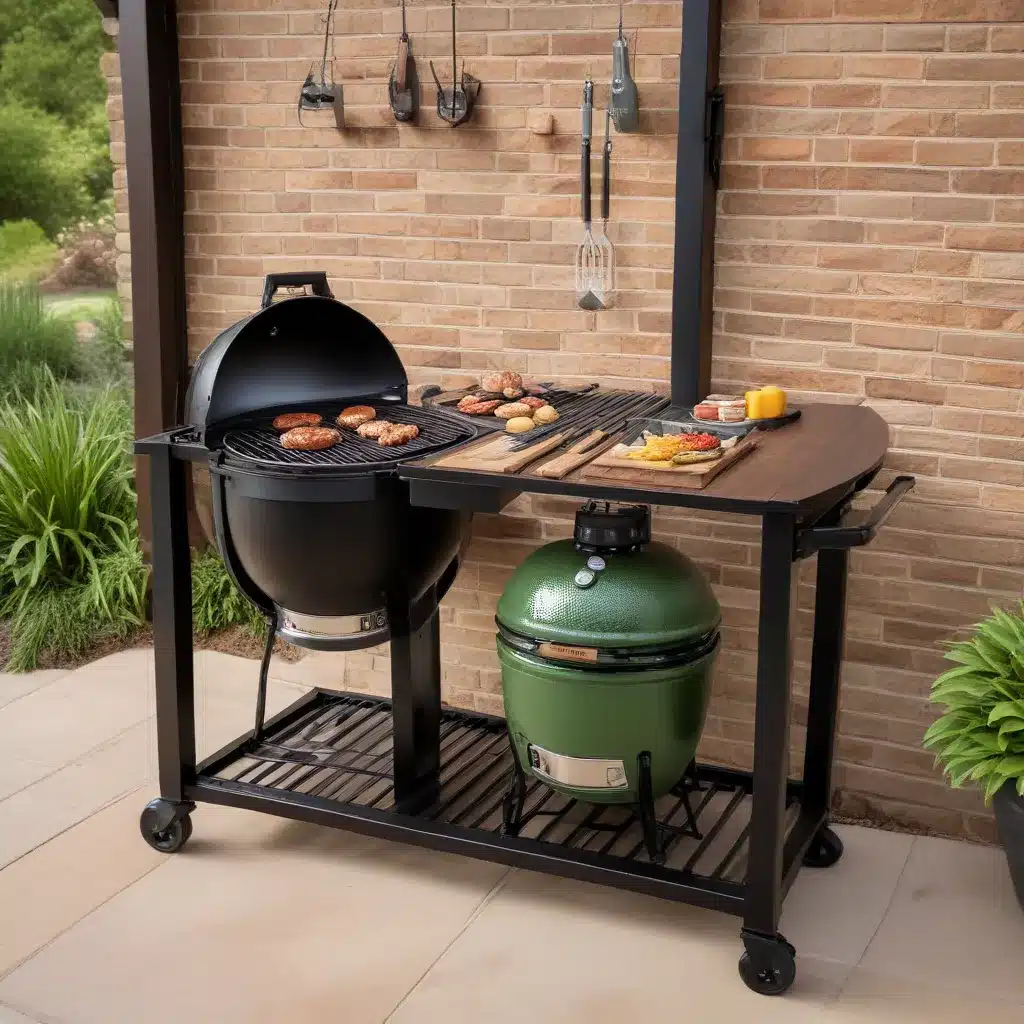
As an experienced barbecue pitmaster, I’ve had the pleasure of experimenting with a wide variety of grilling and smoking equipment over the years. From traditional charcoal setups to modern pellet grills, I’ve encountered countless ways to coax out the most delectable flavors from my favorite cuts of meat. But one grill that has consistently captivated my attention is the kamado-style cooker.
The Kamado Advantage
Imagine a grill that can seamlessly transition from searing steaks to slow-smoking briskets, all while maintaining precise temperature control and unparalleled heat retention. That’s the hallmark of a kamado-style grill. These ceramic cookers, inspired by the ancient Japanese design, have become a true cornerstone in the world of backyard barbecue.
What sets kamado grills apart is their unique construction. The thick, insulated walls of the ceramic body act as a thermal flywheel, absorbing and slowly releasing heat to create an incredibly even and consistent cooking environment. This allows you to achieve a wide range of cooking techniques, from high-heat searing to low-and-slow smoking, all with the same piece of equipment.
Mastering the Kamado Technique
As with any specialized cooking method, there’s a certain finesse to using a kamado grill effectively. One of the key aspects is temperature control. The vents at the top and bottom of the grill act as the primary means of airflow regulation, allowing you to fine-tune the internal temperature with remarkable precision.
When preheating your kamado, it’s important to fully open the bottom vent and leave the top vent slightly cracked. This establishes the initial airflow to get the charcoal or wood lump fuel roaring. Once you’ve reached your desired temperature, typically around 450-500°F for searing, you can begin closing the vents to throttle back the heat.
For low-and-slow smoking, the approach is a bit different. You’ll want to start with a smaller charcoal or wood chunk load, as the excellent heat retention of the kamado means you won’t need as much fuel to maintain a stable temperature. Slowly closing the vents, both top and bottom, will allow you to dial in temperatures in the 225-275°F range, perfect for smoking briskets, ribs, and other tough cuts.
Mastering the Flavors
Beyond the technical aspects of kamado cooking, these versatile grills also offer an unparalleled opportunity to experiment with different wood flavors. The porous ceramic walls of the kamado act as an efficient conduit for smoke, allowing you to infuse your food with a rich, complex aroma that’s simply hard to replicate with other grill types.
When it comes to wood selection, the options are vast. Hickory, oak, and mesquite are classic choices that impart a bold, assertive smoke flavor, while fruitwoods like cherry and apple lend a subtler, sweeter touch. I’ve even had great success using blended wood chunks, like a mix of maple and pecan, to create a truly unique flavor profile.
One of my favorite things about the kamado is the ability to use both direct and indirect cooking methods. For instance, I’ll often start a brisket over a small, wood-fueled fire in the center of the grill, then gradually move it to the perimeter as the cook progresses, allowing the meat to bask in the gentle, enveloping smoke.
Unleashing the Kamado’s Potential
Beyond the realm of traditional barbecue, kamado grills are remarkably versatile. I’ve used mine to bake pizzas, roast whole chickens, and even sear scallops with a perfect charred crust. The even heat distribution and ability to maintain precise temperatures make the kamado an excellent choice for a wide range of culinary applications.
One of the most exciting aspects of kamado cooking, in my opinion, is the opportunity to experiment with different fuel sources. While traditional lump charcoal is a go-to, I’ve had great success incorporating wood chunks, smoking pellets, and even natural hardwood charcoal into my cooking repertoire. Each fuel type imparts its own unique flavor profile, allowing me to tailor the end result to my specific preferences.
Choosing the Right Kamado
With the growing popularity of kamado-style grills, the market has become quite saturated with options. When selecting a kamado for your backyard, it’s important to consider factors like size, construction quality, and overall features.
Larger models, typically in the 18-24 inch range, offer more cooking space and the ability to accommodate larger cuts of meat, while smaller 13-16 inch versions are better suited for intimate gatherings or quick weeknight meals. The thickness and composition of the ceramic body also play a role in heat retention and durability, so be sure to do your research and read reviews.
Many modern kamado grills also come equipped with convenient features like built-in temperature gauges, ash drawers, and even WiFi connectivity for remote monitoring and control. While these bells and whistles aren’t strictly necessary, they can certainly enhance the overall user experience and make your life as a pitmaster a bit easier.
Embracing the Kamado Lifestyle
Ultimately, the true joy of owning a kamado grill lies in the sense of camaraderie and community that often surrounds it. Whether you’re participating in a local barbecue competition or hosting a backyard gathering with friends, these versatile cookers have a way of bringing people together through the shared love of exceptional smoked and grilled fare.
As I reflect on my own experiences with kamado grilling, I’m reminded of the countless hours spent tinkering with wood blends, experimenting with new recipes, and engaging in good-natured debates with fellow pitmasters about the merits of different cooking techniques. It’s a passion that transcends mere food preparation and becomes a way of life, a constant pursuit of culinary perfection.
So, if you’re a seasoned barbecue enthusiast or simply looking to elevate your outdoor cooking game, I invite you to explore the world of kamado grilling. Unlock the full potential of your backyard kitchen and embark on a journey of flavor, technique, and camaraderie that will leave a lasting impression on all who gather around your grill.

